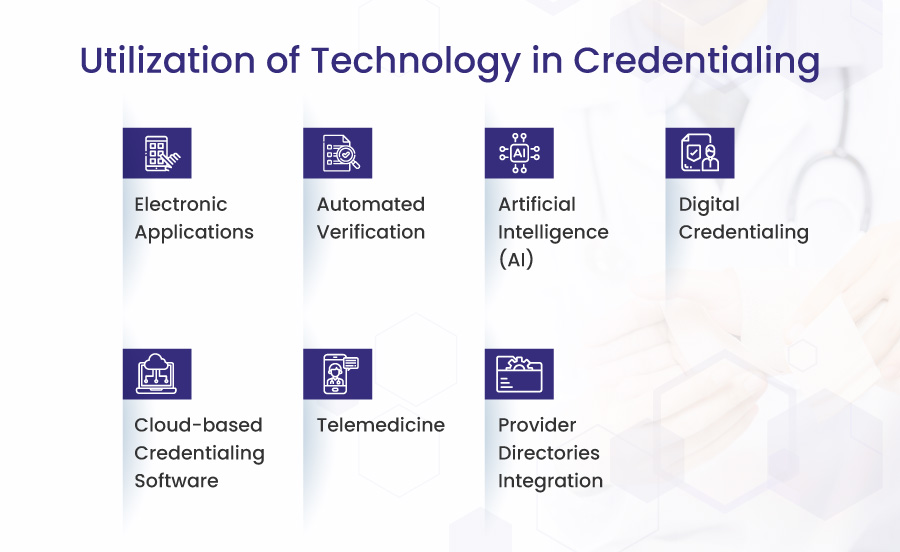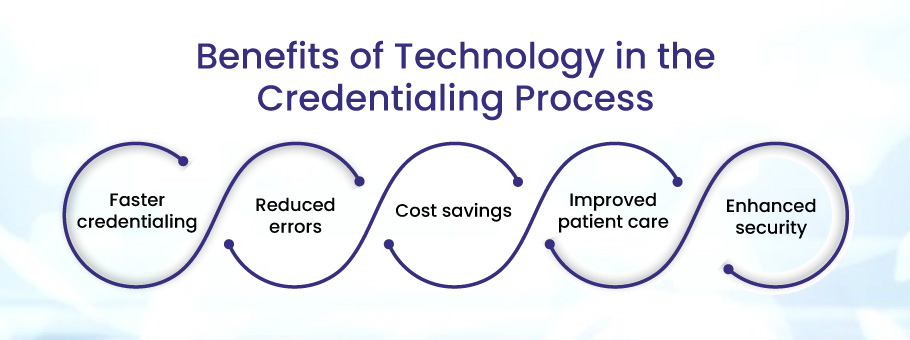Medical credentialing is essential to verify healthcare providers’ qualifications and competence. It involves thoroughly investigating a healthcare provider’s education, training, licensure, and professional experience. The medical credentialing process ensures that healthcare providers meet the minimum standards of competence required to practice medicine safely and effectively. However, medical credentialing can be complex, time-consuming, and costly. In recent years, technology has been increasingly crucial in streamlining the medical credentialing process. This blog will explore how technology simplifies the medical credentialing process.
Overview of the Medical Credentialing Process
Medical credentialing involves verifying healthcare providers’ qualifications, experience, and background.
The process usually involves the following steps:

Submit an Application
Healthcare providers submit their credentials to the credentialing organization, typically a hospital or a health plan.
Primary source verification
The credentialing organization verifies the healthcare provider’s credentials by contacting the primary source of each credential. For example, the organization will contact medical schools to verify education, state medical boards to verify licensure, and previous employers to verify work experience.
Background checks
The credentialing organization performs background checks on healthcare providers, including criminal history, malpractice history, and sanctions by medical boards or other regulatory agencies.
Committee review
A committee of healthcare professionals reviews the healthcare provider’s credentials to determine if they meet the minimum standards to practice medicine safely and effectively.
Final Decision
The credentialing organization decides whether to credential the healthcare provider or not. If the healthcare provider is not credentialed, they may appeal the decision.
The medical credentialing process can take several months to complete, and it can be a costly and labor-intensive process. However, technology has been increasingly crucial in streamlining the medical credentialing process.
Utilization of Technology in Credentialing
Technology simplifies the medical credentialing process in various ways. Let’s discuss how technology is utilized to complete this process smoothly and efficiently.

Electronic Applications
Technology streamlines the credentialing process through electronic applications. Healthcare providers can submit their credentials electronically, which saves time and reduces errors. Electronic applications can also be processed faster, so healthcare providers can be credentialed faster.
Automated Verification
Another way technology has streamlined the medical credentialing process is through automated primary source verification. Credentialing organizations can now use technology to automatically verify healthcare provider’s credentials by accessing databases of primary sources, such as medical schools and state medical boards. This eliminates the need for manual verification, which can be time-consuming and error-prone.
Artificial Intelligence (AI)
Artificial intelligence (AI) is another technology used to streamline the medical credentialing process. AI algorithms can analyze large amounts of data to identify patterns and anomalies that may indicate potential issues with a healthcare provider’s credentials. For example, AI algorithms can analyze malpractice history to identify patterns of behavior that may indicate a higher risk of malpractice.
Digital Credentialing
Digital credentialing is another technology used to streamline the medical credentialing process. Digital credentialing involves creating digital credentials, such as digital badges or certificates, that can be easily shared and verified online. Digital credentials are more secure and efficient than traditional paper credentials and can be verified quickly and easily.
Cloud-based Credentialing Software
Cloud-based credentialing software is another technology used to streamline the medical credentialing process. Cloud-based software allows credentialing organizations to manage the entire credentialing process online, from application submission to committee review and decision. This eliminates the need for manual data entry and paper-based record-keeping, which can be time-consuming and error-prone.
Telemedicine
Telemedicine refers to using technology, such as video conferencing, to provide medical care remotely. With the rise of telemedicine, there has been an increasing need to streamline the medical credentialing process to allow healthcare providers to practice across state lines without going through the lengthy and expensive process of obtaining licenses in each state.
Telemedicine also benefits patients, particularly those in rural or remote areas who may not have access to healthcare services. Telemedicine allows patients to receive medical care without traveling long distances, which can be particularly important for those with chronic conditions or mobility issues.
Provider Directories Integration
Another way technology has streamlined the medical credentialing process is through integration with provider directories. Provider directories are online directories that allow patients to search for healthcare providers based on location, specialty, and other criteria. Credentialing organizations can now integrate their credentialing data with provider directories, allowing patients to easily find credentialed healthcare providers and meet the minimum standards of competence required to practice medicine safely and effectively.
Benefits of Technology in Streamlining the Medical Credentialing Process
The use of technology in streamlining the medical credentialing process offers several benefits, including:

Aster credentialing
Technology allows for faster processing of credentialing applications, which means that healthcare providers can be credentialed more quickly.
Reduced errors
Electronic applications and automated primary source verification reduce manual data entry and validation errors.
Cost savings
Streamlining the credentialing process with technology can result in significant cost savings for healthcare organizations.
Improved patient care
Streamlining the credentialing process with technology can improve patient care by ensuring that healthcare providers meet the minimum standards of competence required to practice medicine safely and effectively.
Enhanced security
Digital credentialing and cloud-based credentialing software provide enhanced security for credentialing data, reducing the risk of data breaches.
Conclusion
The medical credentialing process is necessary to ensure that healthcare providers meet the minimum standards of competence required to practice medicine safely and effectively. Technology offers many benefits, including faster processing, reduced errors, cost savings, improved patient care, and enhanced security. The technology in streamlining the medical credentialing process can revolutionize how healthcare organizations verify the qualifications and competence of healthcare providers, resulting in improved patient care and better outcomes for all.





